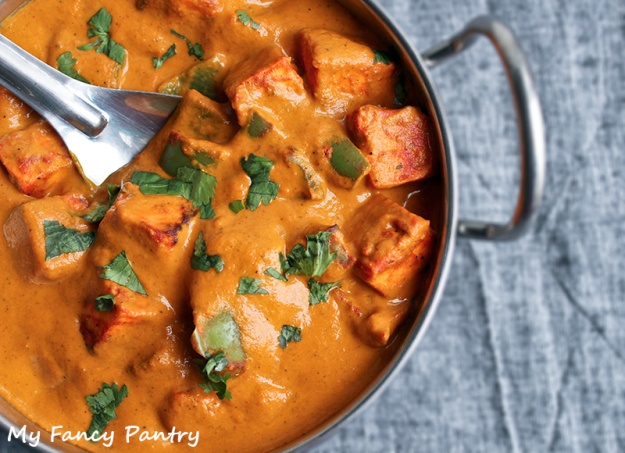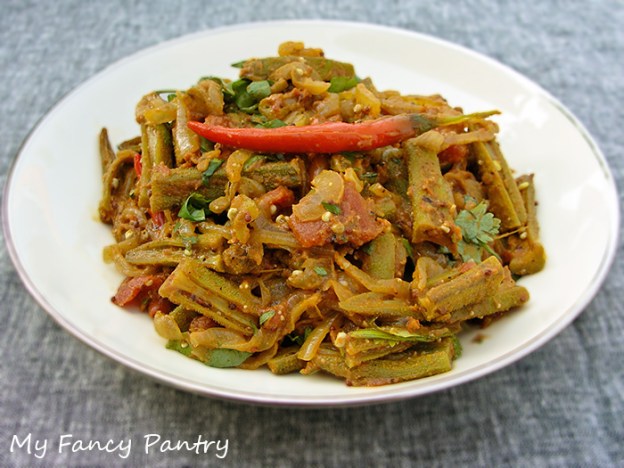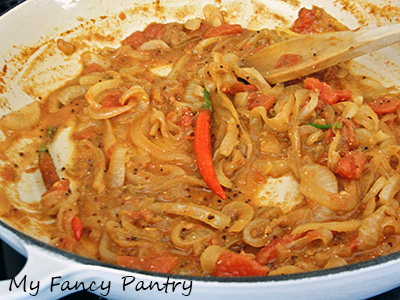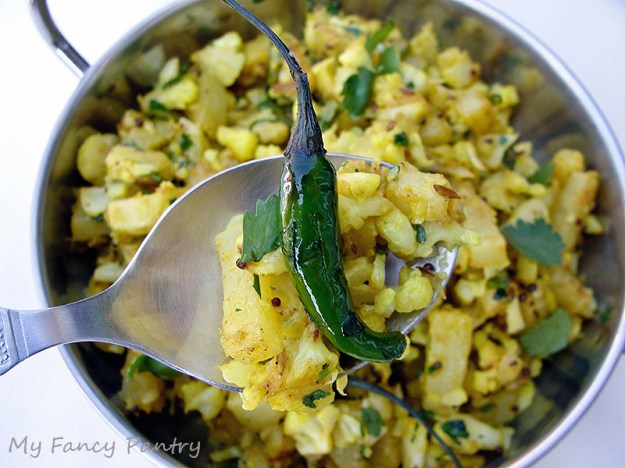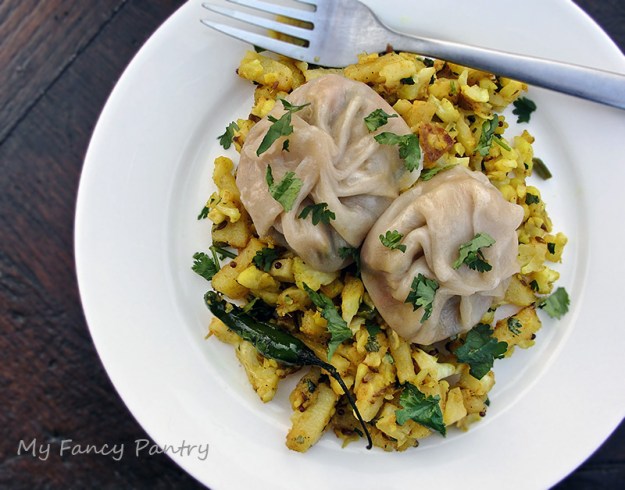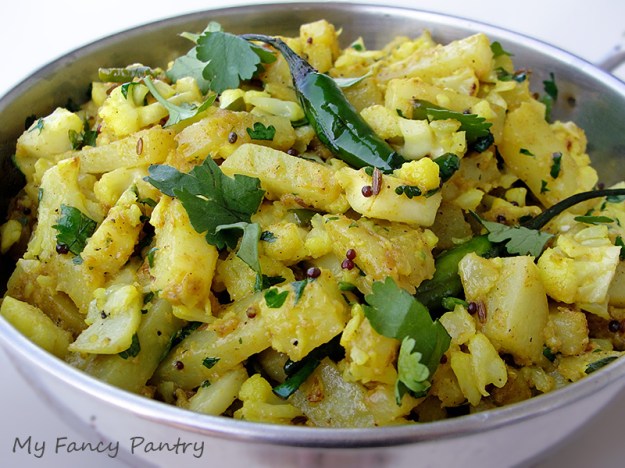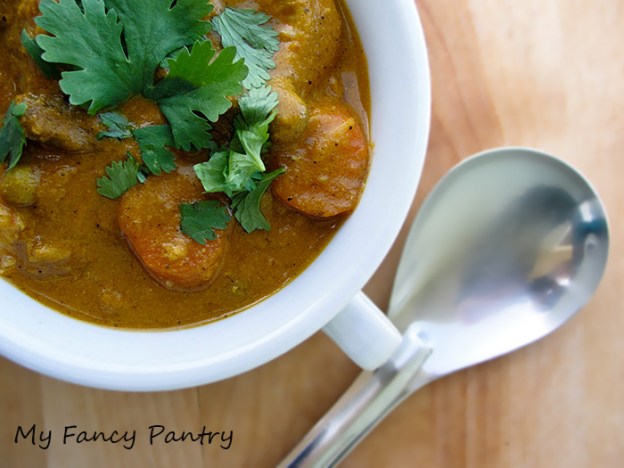I love mushrooms and would have no trouble eating them everyday. They’re a great substitute for meat, a wonderful “filler” for all sorts of vegetarian recipes, but mushrooms are especially good if they’re drenched in a smooth, fragrant, spiced masala.
That brings me to my newest “creation”: Mushroom, Pea and Fenugreek Korma. In Hindi it would be called something like Khumb, Matar and Methi Korma —but don’t completely trust me on that.
My Hindi is not good, and practically non-existant. I speak Hindi like a two year old. In fact, I know the important words (mostly swear words learned from Hindi movies) and I’m fluent in exactly 4 sentences:
The girl is eating.
The boy is eating.
The girl is drinking.
The boy is drinking.
I shouldn’t even be talking about my Hindi skills though, because my husband will probably read this and then he’s going to lecture me about learning Hindi and then he’ll bring up how he bought me Rosetta Stone for my birthday a few years ago and it’s been used approximately 4 times since.
Yes, nothing good can come from that…so lets get back to the curry!
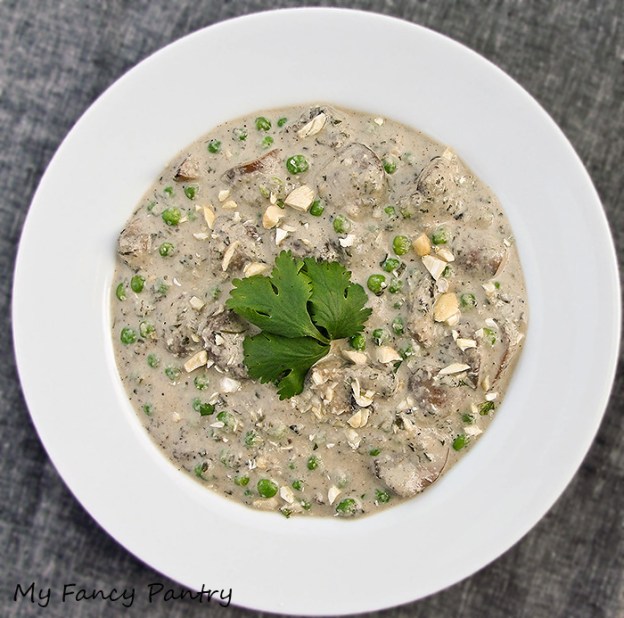
Mushroom, Pea and Fenugreek Korma
Traditionally this dish is more of a Malai curry rather than a Korma, meaning it is made with nuts, milk and a type of milk-cream instead of with nuts and yogurt or coconut milk.
Because I’m very sensitive to dairy (I even break out in hives from it!), I definitely do not indulge on traditional malai curries very often, so I’ve kind of taken a traditional recipe and made it my own.
I started by making a wonderful smelling masala by grinding together:
- a 1″ piece of cinnamon stick
- 3 green cardamoms (only the seeds)
- 4 whole cloves
- 5 black peppercorns
- 2 tbsp. cashew nuts
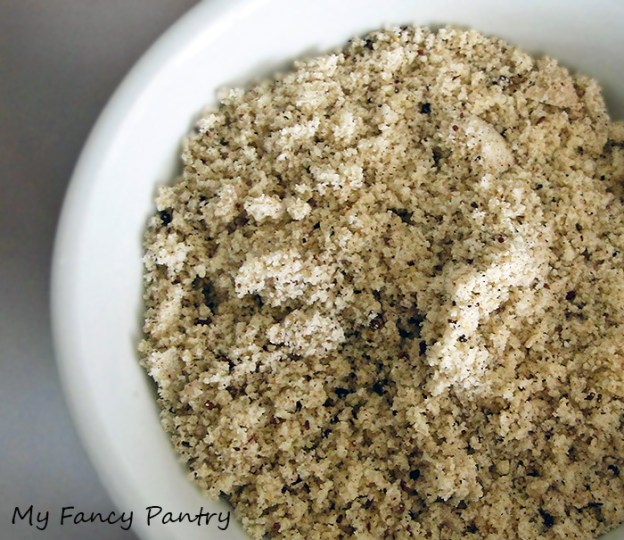
Homemade Masala Mix
Once my masala was made I threw a couple onions into my food processor. I pulsed until the onion was a smooth paste. It was really watery, but no need to worry! Water evaporates.
Then I tossed a little ghee in a pan and tossed the mushrooms in, added some ginger and some garlic, a little salt and some pepper. Once the mushrooms were cooked, I removed them from the pan and set them aside.

Cooked Mushrooms
I then added a little oil to the pan that I had cooked the mushrooms in. I tossed in the onion paste and turned the heat to low. I cooked until most of the water had evaporated from the onions, but I didn’t let them brown or caramelize.
At that point, I added the masala paste I had previously made. I let it cook for about a minute, just to get rid of some of that raw smell.
I added some dried fenugreek (methi) leaves and cooked until everything became a homogeneous mixture and was no longer watery.

I added a little garam masala, amchoor (mango powder), chili powder and salt and cooked that for about 2 minutes to ensure the chili powder would no longer be raw.
I tossed in the peas and mushrooms and added a little almond milk, a couple tablespoons of fat free half & half, and a little water. I let the mixture cook until it was the consistency I wanted, and then I garnished it with some fresh coriander leaves and cashew nuts.

This curry was absolutely wonderful, and the smell was incredible! The gravy was thick and rich, and it truly did seem fit for a king!
Mushroom, Pea and Fenugreek Korma
serves 4-6 as a side dish
Because this recipe has it’s roots in Mughali cuisine, it is a very heavy and rich curry…something the Mughal emperors would have enjoyed.
NOTE:This dish can be made vegan by replacing the ghee with oil and leaving out the half & half. Alternatively, if you prefer to use regular milk rather than almond milk…that will work as well.
Ingredients:
Curry
- 10 oz mushrooms: any variety
- 1 cup peas (frozen is fine)
- 4 tbsp. dried fenugreek leaves (kasoori methi)
- 2 tsp. garlic- minced
- 2 tsp. ginger- minced
- 1 tbsp. butter or ghee (may substitute oil)
- 1 tbsp. oil
- 1 large onion- ground to a paste in the food processor
- 1 c. milk, half & half, almond milk or soymilk (I used almond milk for this recipe)
- red chili powder- to taste
- salt- to taste
- 1/2 tsp. garam masala
- a small pinch of amchoor (dried mango) powder- optional, but it adds a nice “sourness” to the curry
- a small pinch of ground nutmeg
- fresh coriander leaves (cilantro) for garnish
Masala Paste
- 3 green cardamoms (only the seeds)
- 4 whole cloves
- 1″ piece of cinnamon stick
- 5 black peppercorns
- 2 tbsp. cashew nuts
Grind together all ingredients for masala powder until they are completely powdered. A coffee grinder works wonderful for this.
Directions for Curry:
- Clean the mushrooms and trim the stems. If they’re big, cut them into bite-size pieces.
- Heat 1 tbsp. butter in a pan over medium-high heat. Turn heat to high and add the mushrooms. Cook until all the water releases from the mushrooms and evaporates. They should take on a little golden color.
- Add the garlic and ginger, a little salt–to taste, and some black pepper–to taste. Cook one more minute and remove from heat.
- Remove mushrooms from pan and keep aside.
- Using the same pan, heat 1 tbsp. oil over medium-high heat. Once the oil is hot, add onion paste and cook until onions no longer smell raw, but don’t let them turn brown or carmelize.
- Add the fresh ground masala powder and cook for about 30 seconds. Toss in the fenugreek leaves and 1/4 c. of milk. Cook on low heat for about 4 minutes or until the milk evaporates.
- Add salt, chili powder, garam masala, pinch of ground nutmeg and amchoor. Cook for a minute or so.
- Add peas and mushrooms into the onion mixture.
- Add 3/4 c. milk (soymilk, almond milk or half & half) so your curry is thickened. If the curry seems too thick, add water until you’re happy with the consistency.
- Boil the curry for a few minutes. Garnish with fresh chopped coriander. Serve with rice or rotis.
On a completely different topic…
This past weekend was the Food Experiments Pie Contest, sponsored by Brooklyn Brewery. I made 300 mini Korma pies that were topped with whipped coconut cream (man, that was a lot of work!), and Piyush and I headed to Minneapolis.

Although we did not win the contest, we had a really fabulous time! We met a lot of really cool people…people I wish we lived closer to (I’m talk’n about you, Journey and Rachel!)
I’ve never entered any contest even remotely close to this before, but now that I–somehow–survived baking 300 little pies myself, I’m totally ready for the next one!!!
Bring. It. On. 🙂
Oh! By the way, if anyone is looking for my Vegetarian Korma recipe, it can be found HERE. Enjoy!


